995 scholarly books by The Institution of Engineering and Technology and 27
have author last names that start with J
995 scholarly books by The Institution of Engineering and Technology and 27
995 scholarly books by The Institution of Engineering and Technology
27 have author last names that start with J have author last names that start with J
27 have author last names that start with J have author last names that start with J
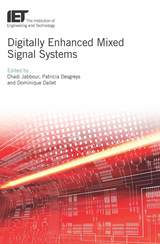
Digitally Enhanced Mixed Signal Systems
Chadi Jabbour
The Institution of Engineering and Technology, 2019
Digitally enhanced analog and mixed signal techniques are increasingly important to current and future circuit and system design. This book discusses how digital enhancement can be used to address key challenges relevant to analog components in terms of shrinking CMOS technology, increasing user demand for higher flexibility and data traffic in communications networks, and the drive to reduce power consumption.
[more]
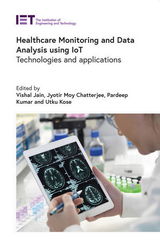
Healthcare Monitoring and Data Analysis using IoT
Technologies and applications
Vishal Jain
The Institution of Engineering and Technology, 2022
IoT-enabled healthcare technologies can be used for remote health monitoring, rehabilitation assessment and assisted ambient living. Healthcare analytics can be applied to the data gathered from these different areas to improve healthcare outcomes by providing clinicians with real-world, real-time data so they can more easily support and advise their patients.
[more]
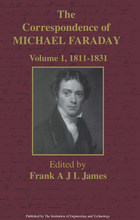
The Correspondence of Michael Faraday
1811-1831, Volume 1
Frank A.J.L. James
The Institution of Engineering and Technology, 1991
Michael Faraday (1791-1867) was one of the most important men of science in nineteenth century Britain. His discoveries of electro-magnetic rotations (1821), and electro-magnetic induction (1831) laid the foundations of the modern electrical industry. His discovery of the magneto-optical effect and of diamagnetism (1845) led him to formulate the field theory of electro-magnetism, which forms one of the cornerstones of modern physics.
[more]
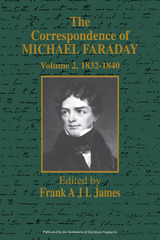
The Correspondence of Michael Faraday
1832-1840, Volume 2
Frank A.J.L. James
The Institution of Engineering and Technology, 1993
Michael Faraday (1791-1867) was one of the most important men of science in nineteenth century Britain. His discoveries of electromagnetic rotations (1821) and electro-magnetic induction (1831) laid the foundations of the modern electrical industry. His discovery of the magneto-optical effect and diamagnetism (1845) led him to formulate the field theory of electro-magnetism, which forms one of the cornerstones of modern physics.
[more]
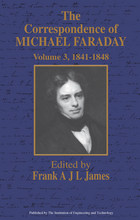
The Correspondence of Michael Faraday
1841-1848, Volume 3
Frank A.J.L. James
The Institution of Engineering and Technology, 1996
Michael Faraday (1791-1867) was one of the most important men of science in nineteenth century Britain. His discoveries of electromagnetic rotations (1821) and electro-magnetic induction (1831) laid the foundations of the modern electrical industry. His discovery of the magneto-optical effect and diamagnetism (1845) led him to formulate the field theory of electro-magnetism, which forms one of the cornerstones of modern physics.
[more]
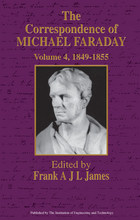
The Correspondence of Michael Faraday
1849-1855, Volume 4
Frank A.J.L. James
The Institution of Engineering and Technology, 1999
Michael Faraday (1791-1867) was one of the most important men of science in nineteenth century Britain. His discoveries of electromagnetic rotations (1821) and electro-magnetic induction (1831) laid the foundations of the modern electrical industry. His discovery of the magneto-optical effect and diamagnetism (1845) led him to formulate the field theory of electro-magnetism, which forms one of the cornerstones of modern physics, and is one of the subjects covered in this volume.
[more]
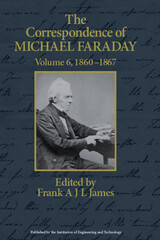
The Correspondence of Michael Faraday
1860-1867, Volume 6
Frank A.J.L. James
The Institution of Engineering and Technology, 2011
Michael Faraday (1791-1867) was one of the most important men of science in nineteenth century Britain. His discoveries of electro-magnetic rotations (1821) and electro-magnetic induction (1831) laid the foundations of the modern electrical industry. His discovery of the magneto-optical effect and diamagnetism (1845) led him to formulate the field theory of electro-magnetism, which forms one of the cornerstones of modern physics. These and a whole host of other fundamental discoveries in physics and chemistry, together with his lecturing at the Royal Institution, his work for the state (including Trinity House), his religious beliefs and his lack of mathematical ability, make Faraday one of the most fascinating scientific figures ever. All these aspects of his life and work and others, such as his health, are reflected in his letters which, in this final volume, cover Faraday's life to his death in August 1867. Also published here are letters that could not be dated and letters that should have been included in volumes one to five but which had not been located when those volumes were published. In total just over 80% of the letters in this volume are previously unpublished. The dominant topic of the 1860s (covered in nearly 40% of the letters) is Faraday's involvement with the lighthouse service relating in particular to his advice to Trinity House and the Board of Trade on matters such as electric light and the controversial issue of fog signals. Also detailed is the complex process by which his various posts were transferred to John Tyndall. Similar issues existed with Faraday's gradual withdrawal from his duties at the Royal Institution, including the misguided attempt to make him President. And, of course, running through many of the letters are comments on his declining health and impending death. Major correspondents include the Astronomer Royal G.B. Airy, the Secretary of Trinity House P.H. Berthon, the Birmingham glassmaker J.T. Chance, the Assistant Secretary of the Board of Trade T.H. Farrer, the German mathematician Julius Plücker, the Cambridge trained mathematical natural philosophers James Clerk Maxwell and William Thomson, Faraday's colleagues at the Royal Institution Henry Bence Jones, John Tyndall and Benjamin Vincent, the Swiss chemist Christian Schoenbein and the astronomer James South.
[more]
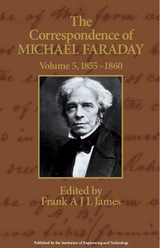
The Correspondence of Michael Faraday
1855-1860, Volume 5
Frank A.J.L. James
The Institution of Engineering and Technology, 2008
Michael Faraday (1791-1867) was one of the most important men of science in nineteenth century Britain. His discoveries of electro-magnetic rotations (1821) and electro-magnetic induction (1831) laid the foundations of the modern electrical industry. His discovery of the magneto-optical effect and diamagnetism (1845) led him to formulate the field theory of electro-magnetism, which forms one of the cornerstones of modern physics.
[more]

Geometrical Theory of Diffraction for Electromagnetic Waves
Graeme L. James
The Institution of Engineering and Technology, 1986
The continuous development of the Geometrical Theory of Diffraction (GTD), from its conception in the 1950s, has now established it as a leading analytical technique in the prediction of high-frequency electromagnetic radiation and scattering phenomena. Consequently, there is an increasing demand for research workers and students in electromagnetic waves to be familiar with this technique. In this book they will find a thorough and clear exposition of the GTD formulation for vector fields. It begins by describing the foundations of the theory in canonical problems and then proceeds to develop the method to treat a variety of circumstances. Where applicable, the relationship between GTD and other high-frequency methods, such as aperture field and the physical optics approximation, is stressed throughout the text. The purpose of the book, apart from expounding the GTD method, is to present useful formulations that can be readily applied to solve practical engineering problems. To this end, the final chapter supplies some fully worked examples to demonstrate the practical application of the GTD techniques developed in the earlier chapters.
[more]

Handbook of Microstrip Antennas, Volume 1
J.R. James
The Institution of Engineering and Technology, 1989
This book presents a wide ranging coverage of principles, state-of-the-art design and up-to-date applications of microstrip antennas; Includes detailed explanations of a variety of analytical techniques from transmission line theory to moments methods and their applications to CAD; Covers the numerous patch designs and array configurations giving many examples of practical applications; Discusses microstrip technology in detail including substrates, processing and environmental aspects; Addresses measurement methods particular to printed antennas such as substrate and connector characterisation and near field probing; Application areas covered include antennas for satellite terrestrial and mobile communications, conformal and aerospace antennas, phased arrays, hyperthermia applicators and millimetric antennas.
[more]

Handbook of Microstrip Antennas, Volume 2
J.R. James
The Institution of Engineering and Technology, 1989
This book presents a wide ranging coverage of principles, state-of-the-art design and up-to-date applications of microstrip antennas; Includes detailed explanations of a variety of analytical techniques from transmission line theory to moments methods and their applications to CAD; Covers the numerous patch designs and array configurations giving many examples of practical applications; Discusses microstrip technology in detail including substrates, processing and environmental aspects; Addresses measurement methods particular to printed antennas such as substrate and connector characterisation and near field probing; Application areas covered include antennas for satellite terrestrial and mobile communications, conformal and aerospace antennas, phased arrays, hyperthermia applicators and millimetric antennas.
[more]

Microstrip Antenna Theory and Design
J.R. James
The Institution of Engineering and Technology, 1981
In the past few years, the concept of creating microwave antennas using microstrip has attracted increasing attention and viable practical designs are now emerging. The purpose of this monograph is to present the reader with an appreciation of the underlying physical action, up-to-date theoretical treatments, useful antenna design approaches and the overall state-of-the-art situation. The emphasis is on antenna engineering design, but to achieve this goal it has been necessary to delve into the behaviour of microstrip in a much wider sense and also include aspects of electromagnetic analysis. As a consequence, the monograph will also be of interest to microstrip circuit designers and to some extent those seeking electromagnetic problems of a challenging nature.
[more]
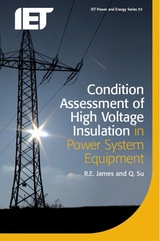
Condition Assessment of High Voltage Insulation in Power System Equipment
R.E. James
The Institution of Engineering and Technology, 2008
The book introduces the reader to the major components of a high voltage system and the different insulating materials applied in particular equipments. During a review of these materials, measurable properties suitable for condition assessment are identified. Analyses are included of some of the insulation fault scenarios that may occur in power equipment. The basic facilities for carrying out tests on the internal and external insulation structures at high and low voltages are described. Tests and measurements according to specifications, on-site requirements and research investigations are considered. Advances in the application of digital techniques for detection and analyses of partial discharges are discussed and methods in use, or under development, for service condition monitoring are described. These include the utilization of new sensors, the solution of online problems associated with noise rejection and the adaptation of artificial intelligence techniques for incipient fault diagnosis.
[more]

Digital Signal Filtering, Analysis and Restoration
Jiří Jan
The Institution of Engineering and Technology, 2000
The processing and analysis of signals and data is today a fast-growing and crucial activity in a diverse range of fields, not only in communications and image technology itself but in almost every other research area in science. The purpose of this book is to explain some of the theoretical concepts that underly the methods now in common use. The author starts from the assumption that some knowledge of the basic principles should be in the toolkit of every engineer or scientist working with signals or data.
[more]
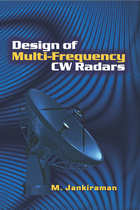
Design of Multi-Frequency CW Radars
M. Jankiraman
The Institution of Engineering and Technology, 2007
This book deals with the basic theory for design and analysis of Low Probability of Intercept (LPI) radar systems. The design of one such multi-frequency high resolution LPI radar, PANDORA, is covered. This work represents the first time that the topic of multi-frequency radars is discussed in such detail and it is based on research conducted by the author in The Netherlands. The book provides the design tools needed for development, design, and analysis of high resolution radar systems for commercial as well as military applications. Software written in MATLAB and C++ is provided to guide the reader in calculating radar parameters and in ambiguity function analysis. Some radar simulation software is also included.
[more]

Fundamentals of Systems Engineering for Defense Systems Applications
Thomas W. Jeffrey
The Institution of Engineering and Technology, 2017
Fundamentals of Systems Engineering for Defense Systems Applications is a user guide to systems engineering with an emphasis on applications in the defence sector and a practical approach based on putting the theory and tools to work in real-life situations.
[more]

Phased-Array Radar Design
Application of radar fundamentals
Thomas W. Jeffrey
The Institution of Engineering and Technology, 2009
Phased-Array Radar Design is a text-reference designed for electrical engineering graduate students in colleges and universities as well as for corporate in-house training programs for radar design engineers, especially systems engineers and analysts who would like to gain hands-on, practical knowledge and skills in radar design fundamentals, advanced radar concepts, trade-offs for radar design and radar performance analysis.
[more]
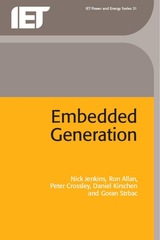
Embedded Generation
Nick Jenkins
The Institution of Engineering and Technology, 2000
The use of combined heat and power (CHP) plants and renewable energy sources reduces the amount of greenhouse gases released into the atmosphere and helps to alleviate the consequent climate change. The policies of many governments suggest that the proportion of electrical energy produced by these sources will increase dramatically over the next two decades. Unlike traditional generating units, these new types of power plant are usually 'embedded' in the distribution system or 'dispersed' around the network. As a result, conventional design and operating practices are no longer applicable; for example, power protection principles have to be revised and complex economic questions need to be resolved.
[more]
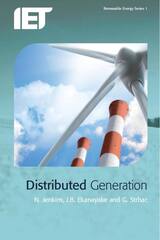
Distributed Generation
Nick Jenkins
The Institution of Engineering and Technology, 2010
Throughout the world there is concern over the impact of energy use on the environment (particularly CO2 emissions) and also over the security of fossil fuel supplies. Consequently, governments and energy planners are actively encouraging alternative and cleaner forms of energy production such as renewables (e.g. wind, solar, biomass) and combined heat and power (CHP).
[more]
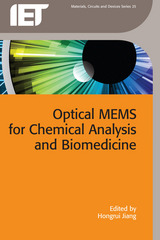
Optical MEMS for Chemical Analysis and Biomedicine
Hongrui Jiang
The Institution of Engineering and Technology, 2016
Optical MEMS are micro-electromechanical systems merged with micro-optics. They allow sensing or manipulating optical signals on a very small size scale using integrated mechanical, optical, and electrical systems and hold great promise specifically in biomedical applications, among others.
[more]
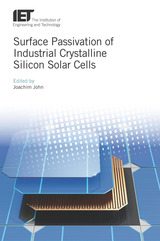
Surface Passivation of Industrial Crystalline Silicon Solar Cells
Joachim John
The Institution of Engineering and Technology, 2019
Surface passivation of silicon solar cells describes a technology for preventing electrons and holes to recombine prematurely with one another on the wafer surface. It increases the cell's energy conversion efficiencies and thus reduces the cost per kWh generated by a PV system.
[more]

Digital Protection for Power Systems
A.T. Johns
The Institution of Engineering and Technology, 1995
Digital protection is based on the use of computers in power line relaying. Since the late 1960s, digital devices and techniques have been applied to almost all new protection schemes. Today the technology is moving towards standardised hardware platforms; at the software level, however, there remains a huge variety in approaches and protection algorithms.
[more]

Power Electronics Packaging Reliability
Mark Johnson
The Institution of Engineering and Technology, 2020
Unpredictable fluctuating loads and exposure to widely varying environmental conditions (including heat, vibration, humidity and dust) present a particularly challenging environment for power electronics modules. This book describes the technologies involved in power electronic device manufacturing with an emphasis on characterising the key wear-out mechanisms and technologies to increase reliability. This book is a must-read for all engineers involved with electronics or reliable power systems.
[more]

Digital Signal Processing
Principles, devices and applications
N.B. Jones
The Institution of Engineering and Technology, 1990
Recent progress in the design and production of digital signal processing (DSP) devices has provided significant new opportunities to workers in the already extensive field of signal processing. It is now possible to contemplate the use of DSP techniques in cost-sensitive wide bandwidth applications, thereby making more effective use of the large body of available signal processing knowledge. Digital signal processing, long the province of telecommunications is, in both research and applications contexts, of growing importance in fields of medical signal analysis, industrial control (particularly robotics), in the analysis and synthesis of speech and in both audio and video entertainment systems. The growing demand for engineering skills in these areas has led to the writing of this book and the presentation of the material of the book at an lEE-sponsored Vacation School at the University of Leicester.
[more]
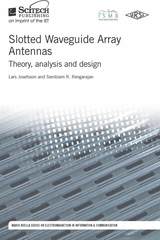
Slotted Waveguide Array Antennas
Theory, analysis and design
Lars Josefsson
The Institution of Engineering and Technology, 2018
Slotted waveguide antenna arrays are used in radar, communication and remote sensing systems for high frequencies. They have linear polarization with low cross-polarization and low losses but can also be designed for dual polarizations and phase steered beams.
[more]

Essentials of Electromagnetic Compatibility Engineering
Randy J. Jost
The Institution of Engineering and Technology, 2016
Electromagnetic compatibility (EMC) engineering has grown rapidly as a field as systems have become smaller. More compact systems have resulted in increased interference and leakage problems, thus making it almost every design engineer's mission to seek and eliminate EMC-related problems before production commences.
[more]

Aperture Antennas and Diffraction Theory
E.V. Jull
The Institution of Engineering and Technology, 1981
Two powerful techniques for the analysis of aperture antennas are now used. One is based on the convenient Fourier transform relationship between aperture field and far-field radiation pattern. Here this relationship is derived from the plane wave spectrum representation of the aperture fields. In the near field of the aperture, Fourier transforms become Fresnel transforms. Far-field patterns may be predicted from near-field measurements by treating the near field as the aperture plane. In its application this method is basically the Kirchhoff approximation of diffraction theory. It is accurate for the forward fields of large antennas but cannot provide the lateral and back radiation.
[more]
READERS
Browse our collection.
PUBLISHERS
See BiblioVault's publisher services.
STUDENT SERVICES
Files for college accessibility offices.
UChicago Accessibility Resources
home | accessibility | search | about | contact us
BiblioVault ® 2001 - 2024
The University of Chicago Press









